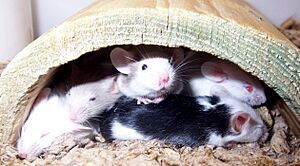Mouse facts for kids
Quick facts for kids MouseTemporal range: ate Miocene – Recent
|
|
|---|---|
 |
|
| House mouse, Mus musculus | |
| Scientific classification | |
| Kingdom: | |
| Phylum: | |
| Class: | |
| Order: | |
| Superfamily: | |
| Family: | |
| Subfamily: | |
| Genus: |
Mus
Linnaeus, 1758
|
A mouse (plural: mice) is a small rodent. Rodents are a type of mammal. Mice have a pointed nose, small round ears, and a scaly tail about as long as their body. They also have many babies quickly.
The most famous mouse is the common house mouse (Mus musculus). Many people keep them as pets. Some kinds of field mice are also common in certain areas. They might go into homes looking for food or a safe place to stay.
Mice are sometimes used in science experiments. They are also popular pets. Some mice can carry diseases. Because of this, some people see mice as pests. But many others think mice are cute and fun animals.
Since mice are rodents, they are related to animals like squirrels, rats, and beavers. Mice eat weeds, seeds, and berries. Animals like owls, foxes, and cats often hunt and eat mice.
Contents
Different Kinds of Mice
The word "mouse" usually means a small murine. But sometimes it is used for other small rodents that are not closely related. The murines are the biggest group of mammals. They are even larger than most mammal orders.
The Common House Mouse
The common house mouse is often seen as a pest. These mice are usually found living in human homes.
Voles Are Not Mice
Voles are small rodents, but they are not true mice. They belong to a different family of rodents.
Deer Mice of the Forest
Deer mice are also not true mice, or they are only distantly related. These mice live in forests. They can run and jump better than many other small rodents. This is how they got their name, because they move like deer.
The grasshopper mouse is an interesting type. It rarely eats other mice. Instead, it prefers to eat grasshoppers and other insects. This mouse is also only a distant relative of true mice.
Mice as Pets
Many people choose to buy mice as pets. Pet mice can be playful and loving. They can also get used to being held by people. Like pet rats, pet mice should not be left alone outside. They have many natural enemies, such as birds, snakes, lizards, cats, and dogs.
Male mice often have a stronger smell than female mice. However, mice are very clean animals. They groom themselves carefully and never need baths as pets. If you take good care of them, mice can be great pets.
Here are some common things you need for pet mice:
- Cage – You can use a hamster or gerbil cage. There are also special cages made just for mice. Make sure the cage has a secure door.
- Food – You can buy special food for mice. This food comes in pellets or is made of seeds. Mice can usually eat most rodent foods. This includes food made for rats, hamsters, or gerbils.
- Bedding – Bedding is usually made from soft wood pulp, like aspen. Sometimes it is made from shredded, uninked paper or recycled wood pulp. It is best to avoid using corn husk bedding. This type of bedding can grow a type of mold called Aspergillus fungus when it gets wet. This mold can be bad for their feet.
What Do Mice Eat?
In the wild, mice mostly eat plants. They enjoy all kinds of fruit and grain from plants. However, mice are very good at living in cities and towns. They are known for eating almost any type of food scraps they find. When kept as pets, mice are usually fed special mouse food pellets. These foods have all the nutrients they need. But pet mice still enjoy a variety of fresh vegetables.
Famous Mice in Media
Two very famous mice in popular culture are Disney characters. These are Mickey and Minnie Mouse. Even though they are mice, they can walk, talk, and act like people.
Chuck E. Cheese is another well-known mouse. He is the mascot for Chuck E. Cheese's pizza restaurants.
Images for kids
-
House mouse (Mus musculus)
-
Knockout mouse (left) and normal mouse (right)




